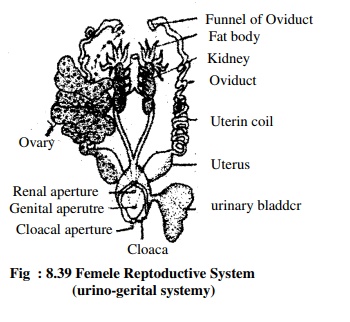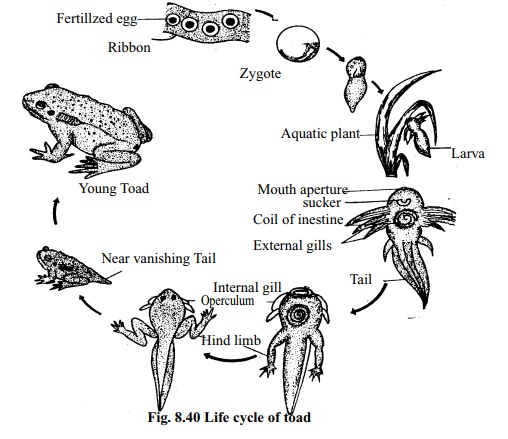Chapter: Biology: Structural Organization and Acquaintance of Animals
Toad: Reproductives system
Reproductives system
Reproduction is a physiological function. It is necessary for the continuance of species, so that it does not become extinct. This process can be accomplished asexually or by sexual process with the help of the opposite sex of the same species. The offsprings produced as a result of reproduction get mature and the process is repeated. In this way the continuance of a species is maintained with the help of the opposite sex of the same species. Those organs which take direct part in reproduction are called reproductive organs and the system is known as reproductive system. Toad is a unisexual animal. Male reproductive organs arepresent in the male toad and female reproductive organs are present in the female toads. Below is a description of the male and female reproaductive systems.
Male reproductive system : In the male toad the organs which take direct partin reproduction are-
1. A pair of testis
2. A pair of vasa efferentia
3. Urino-genital duct or vas deferens
4. Cloaca
5. Cloacal aperture.
Testis: In the male toad on the dorsal side of the abdominal cavity twoelongated, slightly yellowish testes are present. These are attached with the kidneys. Sometimes they are divided in pieces. The testis remains attached with the kidney by a thin membrane called mesorchium. Each testis is formed of innumerable seminiferous tubules. Sperms are produced from the inner walls of these tubules.
Vas efferens: Some smaller ducts coming out from the testis remain directlyconnectd with the collecting ducts of the kidney: These fine ducts are called vasa efferentia. Sperms from the testis enter the urino-genital duct through these ducts.
Vas deferens or Uriono-genital duct: A duct comes out from the convexsurface of each kidney. It is the sperm duct or vas-deferens of male toad. Urine and sperms both flow through this tube. So it is also called urino genital duct. Each duct becoming dilated forms the seminal vesicle below the kidney.
Cloaca: Behind the rectum the common chamber where the rectum andurino-genital duct opens is called cloaca. Through this sperms can pass towards the cloacal aperture.
Cloaca aperture: The aperture situated at the extreme posterior end of thebody is called cloacal aperture. Sperms are discharged outside through this aperture.
Bidders's organ: This red coloured organ is situated at the anterior part of eachtestis. It is an inactive organ in male toad and in female toad it remains in immature condition. It vanishes in mature female toad but persists in mature male toad with small size. Its function is not yet known.
Fat Body: Finger like yellow coloured organs are situated at the anterior endsof the kidneys of both the male and female toads. Fatty substance remains stored in it and hence it is called fat body. The reproductive cells get nourishment from this fat body and they also provide nourishment to the toad during hibernation.
Female reproductive system
The organs which form the female reproductive system of toad are
1. A pair of ovaries
2. A pair of oviducts
3. A pair of uteri
4. Female genital aperture.
1. Ovary: The female toad has two ovaries. These are situated on the dorsalside of abdominal cavity. They have no definite shape; they grow during the breeding season. Within the ovaries innumerable ova are produced. Matured ova are black and spherical. At this time the two ovaries burst and the ova become scattered.
2. Oviduct: The toad has a pair of narrow, whitish, coiled oviducts. At theanterior end of each duct there is a funnel and the posterior end widens to form
the uterus. The ova enter the oviducts through the funnels.
3. Uterrus : The posterior part of each oviduct becomes dilated to form a sac like structure. This is uterus, where the ova remain stored temporarily. Later the two uteri meet together and open into the cloaca. The urine and ova of the female toad pass into the cloaca through two separate ducts. Later through cloacal aperturethey are discharged from the body.

Life cycle and metamorphosis :
The life cycle of toad is very complex. Rainy season is the breeding season of toad. At this time they become very active. The male toad croaks to attract the female toad. Sexual union occurs between a matured male and a female toad. This sexual union is called mating. During mating the female toad releases eggs in shallow water. The male toad simultaneously releases sperm over the ova. Zygote is formed by the union of sperm and ovum. The zygote is then transformed into an embryo and after passing through various stages, it becomes a mature toad.
Structure of ovum and sperm:
Egg: The ovum is often called an egg. The eggs appear as mustard-grain andcan be seen in naked eyes. The shape of the ovum of toad is rounded, one end is blackish and the other end is whitish in colour. At the blackish end of ovum remains the cytoplasm and nucleus and in the whitish end portion remains the yolk. The amount of yolk in the ovum of the toad is plenty. Each ovum remains covered by a thin membrane. The egg having the yolk side is called a "Telolecithal' egg.
Sperm: The sperm of toad cannot be seen with naked eyes. The sperm cell isdivided into three parts, such as:
Head part, middle part or neck, Tail part
A. Head: The head of the sperm is oval shaped Inside it lies the nucleus. Whereremains the haploid number of chromosomes.
B. Neck or Middle part: The middle small portion between the head and tailof sperm is the neck. In this part of the cell remain centrosome and mitochondria.
C. Tail: The narrow, elongated and motile part of the sperm is called tail. Withthe help of this narrow tail the sperm swims in water.
Fertilization and development:
After the formation of ova in the ovaries of female toad, they pass towards the outer side through the oviducts. At this time the ova are surrounded or covered by albumin and take the shape of transparent ribbon. Inside this ribbon like part ova or eggs are arranged one after another in a row. In contact with water this ribbon like part swells and floats on water with eggs. In this condition union of sperm and ovum takes place. This union of sperm and ovum is called fertilization. The process of fertilization takes place in water outside the body of toad: This type of fertilization is called external fertilization.
Each sperm has a tail. When the sperm meets an ovum its tail is dropped. Zygote is formed when the ovum is fertilized by the sperm. Within a few hour of fertilization, the division of zygote begins. Zygote being divided by mitosis process forms an embryo. In this cell division at first a cell divide into two. Then from two, the number of cells becomes four. Soon from four the number increases in a rate of eight, sixteen, thirty two, etc. This change of the zygote is called embryonic development. At this time the embryo passing through many stages or steps becomes transformed into a three-layered embryo. These three layers are Ectoderm, Mesoderm and Endoderm.
1. Ectorderm: The outer layer of the embryo is called ectoderm. This formsthe integument, nervous system and sensory organs.
2. Mesoderm: The middle layer of the embryo is mesoderm. This layer formsconnective tissue, Vascular tissue, muscular tissue, sex organs etc.
3. Endoderm: The innermost layer of the embryo is endoderm. It forms theepithelium of the alimentary canal, liver, lungs, pancreas and other organs. Within two weeks of the fertilization the formation of embryo from zygote is

completed and it comes out breaking the covering of the egg. This stage is called larva or tadpole. The tadpole looks like a fish fry. The body of a tadpole is divided into three parts, a rounded head, a small narrow trunk and a flat tail. On the ventral side of tadpole and at the junction of the trunk and the tail the cloacal aperture is located. Initially the tadpole does not have mouth aperture, limbs and eyes. Instead of mouth aperture there remains a sucker on one side of the mouth. With the help of this sucker the tadpole keeps itself attached to algae or any other aquatic plants. At this time the tadpole does not takes any food; lives by taking nutrition from the yolk of the egg. There remain three pairs of external gills on two sides of the head. with the help of gills the tadpole performs respiration. In later stage mouth is formed at.the side of the sucker. Fins are formed on the upper side of the tail in the form of folds. External gills disappear and internal gills are formed inside the body: Coiled alimentary canal is seen indistinctly from the upper side of the body. In the mean time strong jaws are formed in the anterior part of the head. The gills of tadpole remain covered by an operculum like the fish. Oxygen dissolved in water, comes in contact with gills and respiration is performed.
After some days these gills disappear within the body and lungs are formed. In the meantime, first the hind limbs and then the fore limbs are formed. The tail gradually disappears within the body. The alimentry canal is small in size. The sharp parts of the jaws of the mouth are dropped and the mouth aperture widens. At this time the tadpole is transformed into a tiny toad and leaves water. By eating small worms and insects it gradually grows larger.
At one time the tail of the toad completely disappears. The organs of the toad after being well formed, the baby toad is transformed into a full grown toad When the life cycle of the toad is observed it is seen that there are many physical differences between a tadpole and a baby toad. At the time when the tadpole gradually transforms into the future toad, it passes through such intermediate stages with which the body-shape of a full grown toad has no similarity. Such changes of the life cycle of the toad are called metamorphosis The metamorphosis of the toad is controlled by the hormone named Thyroxin.
Related Topics